Posted: April 25th, 2010 | Author: huangyunbo | Filed under: creative industries, real-estate, waste industries | No Comments »
Creative Industries are no doubt with a clean image comparing with those manufacturing counterparts with visible wastes produce. Anyhow, in the article ‘Creative industries or wasteful ones’, Maxwell and his colleagues reveal the dark side or the by-products creative industries create due to heavily relying on electronic technologies. Computers parts, TVs, mobile phones mp3s and other e-devices therefore contribute to a new even more toxic industry- an unbeknown one. The toxic process starts from the unawareness of knowledge of e-waste recycling which involves health risks for workers in the value chain and pollutions to land and water.  And the trend of e-waste from developed countries/regions to developing countries/regions calls for responsibilities both from countries and companies involved. The authors also call for users /public require the ‘clean’ industry be less ‘wasteful ‘by slowing down the business for a while in regarding the proper usage and treatment of e-waste.
It’s indeed an inspiring article which reveal not only how clean becomes wasteful but also the relationship between technology and moral issues. In addition, consumers and civil society can use their power to claim for the right for the workers and a less polluted environment which help to prevent the ‘wasteful ‘ industry not  go too far. In short, we are not facing the challenge of new technologies with unwelcome by-products. Instead, we need to inspect why and how we modern society use it for what purposes. Always do the right things and do things right.
Further thoughts and action plan
Our team got an initial action plan that we’re going to share this e-waste knowledge with local environmental protection NGO to see how academic resource can contribute to local communities .A further study will be conducted in the following days to explore another unbeknown wasteful aspect of the ‘clean industries’ in Ningbo-soil pollution on the demolishied factory sites where new Creative Industries and Real Estate Clusters are built.
Reference
Maxwell, Richard and Miller, Toby (2008a) ‘Creative Industries or Wasteful Ones’, Urban China 33:28-29, http://orgnets.net/urban_china/maxwell_miller
Posted: April 25th, 2010 | Author: huangyunbo | Filed under: creative industries, real-estate | No Comments »
In her article ‘Private homes, Distinct Lifestyles: Performing a New Middle Class’, Li Zhang traces the ongoing formation of a new middle class in China that has a close relationship with the reform of privatizing housing in 1998 which differed from  the former state-subsidized public housing policy.
In a time that the real estate industry becomes the main drive for economic booming in China, her fieldworks in Kunming revealing the link between the privatization of real estate and class  forming focus more on property acquisition and consumption practices that differentiated a ‘happening ‘ middle class. Although it’s a ‘happening ‘ class, Li Zhang observed that the forming middle class shared some cultures cultivated based in the living space( Garden area, Villa or high-end residential areas), such as being wealthy enough to afford  the houses in the same Xiaoqu(Neighborhoods), sharing similar consumption (high-end consumption labeled by specific brands) ,   enjoying same lifestyles(fashion, kids education and housewives’ leisure-time) and with a strong sense of insecurity by the well-gated systems that both act for isolating the relationship with next-door neighbors and protecting  privacy.
 Does a culture of a class just cover the finance status and the sense of insecurity as it’s in Li Zhang’s study? My observations here in Ningbo might well support her concept of ‘happening’ in terms of forming a new class rather than the set material standard shared within the class. The findings in Ningbo high-end neighborhoods show that there is a tendency that some wealthy people who used to show off their labels of personal possessions are now showing more concerns on the design and cultures of the consumer goods(although they are still big brand and expensive). Sales in the LV store found that some people begin ask for a nice good without an eye-catching big label. This shift from showing off to emphasize quality of goods also leads another change-diversified in lifestyles. It’s no longer the time ‘the middle class ‘follows the same activities in their leisure-time/past-times as food massage, Facial treatment and Golf. Some begin to spend more time jogging in the shared gardens and some parents with little children’s unite together to organize for outing.Â
Yet, it’s hard to come to a clear definition of what a ’middle class in China’ looks like at the stage. It’s definitely a process rather than a specific term.
Reference:Zhang, Li (2008) ‘Private Homes, Distinct Lifestyles: Performing a New Middle Class’, in Li Zhang and Aihwa Ong (eds) Privatizing China: Socialism from Afar, Ithaca: Cornell University Press, pp.23-40
Posted: April 23rd, 2010 | Author: huangyunbo | Filed under: creative industries, real-estate, waste industries | No Comments »
This post just recorded an interview to an ex-specialist in Chinese Environmental Protections Authority and personal fieldwork on 22 April, 2010. In Ningbo, some residential clusters and creative industries clusters are built on the site which used to be factories that facing the risk of polluted soil.
 There are some key problems I observed.  First of all, there are no clear standards for soil background survey before the land used to be rebuilt. In additional, the ‘Polluter pays’ principle needed to be improved to specify the responsibilities between the former and current users of the polluted land as well as to specify the roles of different local government departments(Urban planning and construction authorities, Environmental Protection Bureau and the Health Bureau ). Case study will be done for Land of Beijiao Road 151, Ningbo developed by Younger Group for a high-end cluster. Another factor is the lack of public awareness. Especial in a crazy hot time for real estate, consumers don’t have any background knowledge and choices to evaluate the overall conditions of the property before they invest. Although there is little voice trying to question the environmental issues, most investors don’t realize they are in a big risk living/working in a toxic cluster. The aftereffect will be obvious in coming years.
Calls for improvement will focus on policy making and powerful implementation from local governmental level. Developers (companies) should also take responsibility in dealing with the polluted land including background survey before construction and controlling new pollution for the new clusters which are legal and moral requirement for responsible developers. In addition, idea of Environmental Insurance is useful for companies in the case when pollutions happen. Last but not at least would be that public education and media release will help raise the public awareness which might lead to campaigns by buyers or local civil society
Reference Mr. Tang Shiming, Interview on 22 April, 2010
Posted: April 21st, 2010 | Author: huangyunbo | Filed under: creative industries, real-estate | No Comments »
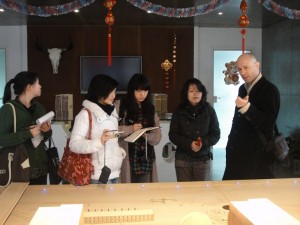 The Urban-Media Networks team visited Ningbo Hefeng Creative Cluster and later the Fortune Creation Cluster on 2nd April, 2010. The initiate aims of the trips were to find out ‘the winners’ and ‘the losers’ in CI; the relationship between CI and Real- Estate industries (HOPSCA, Hotel+Office+Parking+Shopping+Convention+Apartment); and how the investment finance.
The Urban-Media Networks team visited Ningbo Hefeng Creative Cluster and later the Fortune Creation Cluster on 2nd April, 2010. The initiate aims of the trips were to find out ‘the winners’ and ‘the losers’ in CI; the relationship between CI and Real- Estate industries (HOPSCA, Hotel+Office+Parking+Shopping+Convention+Apartment); and how the investment finance.
FindingsÂ
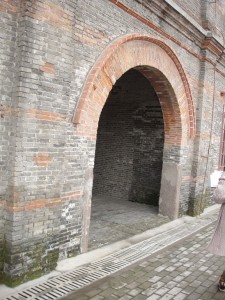
Old factory, new economics
Creative industries have become the most favorite baby for local government and developers in the process of urbanization. One of the main reasons is Promoting Creative Industries is one of Ningbo municipal government’s strategies in industrial optimization. Another factor will be there is a big cake for industrial design. According to a study, there is about 1,000 million (Chinese Yuan) demand for industrial design from Ningbo which contributed to other markets as Shanghai and Beijing due to lack of local competent design companies. In addition, there is a closer link with Real estate (esp. with a hot term as HOPSCA). In Hefeng, as the interviews briefed, besides studios for designers, there will also be other facilities as a fine hotel, offices, shopping areas, nice place as Cafe’s for designers’ network functions’â€, apartments and etc. Same stories as we can see in Fortune Creative Cluster although it now looks like a shopping mall rather than what it supposed to be.
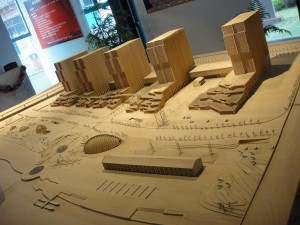
'All in one' HOPSCA
Hefeng Creative Cluster is a stated-own project. It’s financed by governmental investment which according to the interviewee that’ we won’t expect we can make a finance balance within 15-20 years ’. Anyway, we can still see some evidences for it’s a good deal in a long-term period, such as the land value increase, the cash flow from rentals and other service provide, relevant opportunities arise from the business named as CI… (More research on why Ningbo needs HOPSCA)
One of the advantages of Hefeng Cluster includes Good location-really downtown, good river view. Facilities like the Shell-Shaped T- Show hall, with big place and professional facilities which is another selling point to its target local clients. Textile\clothing companies as Younger, Romon, and Peace Bird showed their interests to it. According to their sales, key target customers include other big manufacturers in stationary and sound equipments.
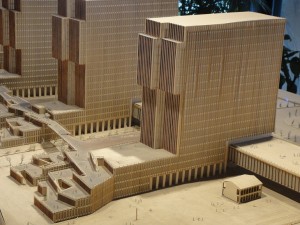 →→→
→→→

Can a model be built to a real one?
Challenges being observed here including Market segmentation and strong competition from other newly set up CI clusters. Lack of Professional management which differ from the current system in residential real-estate management

Some Studios/Companies have started business here...

 Learning for the field trips
Learning for the field trips
- Find out sufficient and proper interviewees. This really a big challenge and a must preparation before the visit. For instant, this time we can not find someone speaks for ‘losers’ …
- Ability to control site visit and interview-to is flexible. Some designed questions can not be answered on spot.
- Teamwork and time management. Team members  contributed to schedule making and arrangement to this first trip which is really a treasure and learning process for the next trips.
 Issues to be followed up on the topic
- The Hefeng Cluster used to be factories and how the former workers relocated?
- What other losers find frustrated when they face the new cluster (Aged people who have to move to places far away)?
- To what level the small investors in the cluster loosing money, like people buying small offices but cannot find enough tenants in the Fortune Creative Cluster?
Posted: April 20th, 2010 | Author: Ned Rossiter | Filed under: creative industries, logistics, maritime industries, theory | No Comments »
The primary task of the global logistics industry is to manage the movement of people and things in the interests of communication, transport and economic efficiencies. Central to logistics is the question and scope of governance – both of labouring subjects and the treatment of objects or things. One of the key ways in which logistics undertakes such work is through the application of technologies of measure, the database and spreadsheet being two of the most common instruments of managerial practice. In the age of cognitive capitalism, new sites of struggle are emerging. Everyone, in short, has the capacity to be produced as creative labour, since the measure of economic value shifts from a logic of scarcity (IPRs) to one of aggregation, recombination and storage that corresponds to the materiality of digital information and social production of value.
See: Neilson, Brett and Rossiter, Ned (forthcoming 2010) ‘Still Waiting, Still Moving: On Migration, Logistics and Maritime Industries‘, in David Bissell and Gillian Fuller (eds) Stillness in a Mobile World, London and New York: Routledge.
Related fieldwork questions:
How would you summarise the work of your company?
Is your trade or business predominantly or largely transnational or is mostly within China? If it’s transnational, does that mean between Europe, the US and China, or does it mean something more regional: East and South Asia perhaps?
Are there differences in supply chain integration depending on whether your business serves foreign or domestic markets? If your company engages both domestic and foreign markets, does this lead to any conflicts in how supply chains are integrated?
If your business is transnational is there a disconnect between Chinese suppliers and Western buyers in terms of business expectations? In other words, how does culture play into the movement of commodities and communication with clients?
How do you understand logistics?
To what extent does logistics impact upon the economy or profitability of your company?
Are there cases or instances when supply chain quality can ever be sacrificed to maintain deals or whether solid deals result in the solid execution of logistics integration? Is the emphasis on getting paid or on supply chain innovation? Or are there tensions here?
If your business is prepared to live with performance gaps for the sake of deals what are the implications for labour performance measurement?
What sort of software programs do you use to measure KPIs (Key Performance Indicators) or ERP (Enterprise Resource Planning) databases?
What sort of time cycle operates with these KPIs – is it an hourly measure or maybe daily or even monthly? Or perhaps it’s a by-the-minute sort of measure on how products and activities are moving along supply chains?
Do you know if workers in your company ever feel under stress to ensure they meet daily KPI targets?
What happens if they don’t meet KPI targets? Are any disciplinary measures taken?
How does the company deal with hold ups in supply chains by partner associates? Are you aware of such holdups via information from the KPIs or ERPs?
Posted: April 18th, 2010 | Author: yangwu | Filed under: creative industries, waste industries | No Comments »
On 9th April, Ned and UMN team scheduled a second field trip for the e-waste topic. Since unfamiliar with e-waste industries at the very beginning, we have done the preparation with not so wise strategies. When I got contacted with one proposed observation spot, a metal waste treatment park, I asked directly about e-waste recycling treatment, and the park personnel denied immediately and explained that it’s because e-waste is illegal to import and the park is mainly dealing with the imported metal waste, so they don’t do e-waste at all. I followed a question of what exactly metal waste in the park. They range from discarded steel and copper to other semi-deconstructed metal waste, for example, some wasteful part of cars or an electrical motor from huge equipment. In fact, it’s hard to distinguish electronic waste from others. The personnel also admitted that sometimes their shipments may have some e-waste inside, but there is pretty small part otherwise custom would detect and forfeit the whole shipment. The final question is asked about that if those waste are not completely de-constructed and then how they deal with them. The personnel confirmed only manual redistribution by workers for current stage. With this telephone interview, as we were informed no e-waste spot could be available to visit, we gave up the original proposal. However, in the class discussion later on, our team member Angela provided some important information from her friend who works in the park confirming that there are some factories doing e-waste treatment informally.
The final field trip was to visit some second-hand electronic product (e-product) markets. In the morning, we firstly visited Tianyi Digital Plaza and then YiGao Digital Plaza. Both sell brand-new e-products, repair the broken, purchase the old and resell the second-hand. When we visited the floor especially bearing upon old e-products, we randomly interviewed some shop owners while not so many of them willing to answer our questions. We learned that currently the old product sources are mainly from domestic, and just a few from the foreign countries which is less and less because of the channel to get them is illegal (the same reason mentioned by the personnel from waste park). We also found even in a small market, there exist some business chains. For example, some only repair the chip-boards for second-hand e-product shops.
After team lunch, Mukda, Yulin and I visited South Gate Market, the biggest old product market in Ningbo. We could see a lot of old products sold or discarded by their previous users redistribute there, some lots of crashed televisions, some for air conditioners. We tried to search second-hand e-product shops, but, quite rare could be found before we jumped in the one introduced by a friend who had experience buying old stuffs here. Afterwards we understood that the declining number of second-hand e-product shops is because of less profit margin squeezed by decreased prices of new e-products and less customers. We chatted with staffs there and watched them working on the site. They introduced that after collecting back some old products, the first step is to de-construct each part and test performance. If any part is broken, they will try to repair or get a replacement. Then, it will be cleaned and reassembled to a well-functioned one for customer selection. Regarding those useless parts or unsold e-products, they consider them as absolute e-waste and move them out. Some junk man from Guangdong province or TaiZhou district would come and collect them. These e-wastes are sold per kilogram, and the prices are quite regularly fluctuated and mostly decided by raw material market. When transported to the following destination, these e-wastes will be crashed down in order to extract metal materials.
During this field, we found two different characters practically bound with these old e-products: e-waste and secondary resource. Regards with the industries chain or network, it might be the end of a chain as so called e-waste; on the other hand, it is the starting point as the secondary resource of a new industry chain.
1. Below are a few pictures of the field work.

TianYi Digital Plaza_Third floor for old e-product market
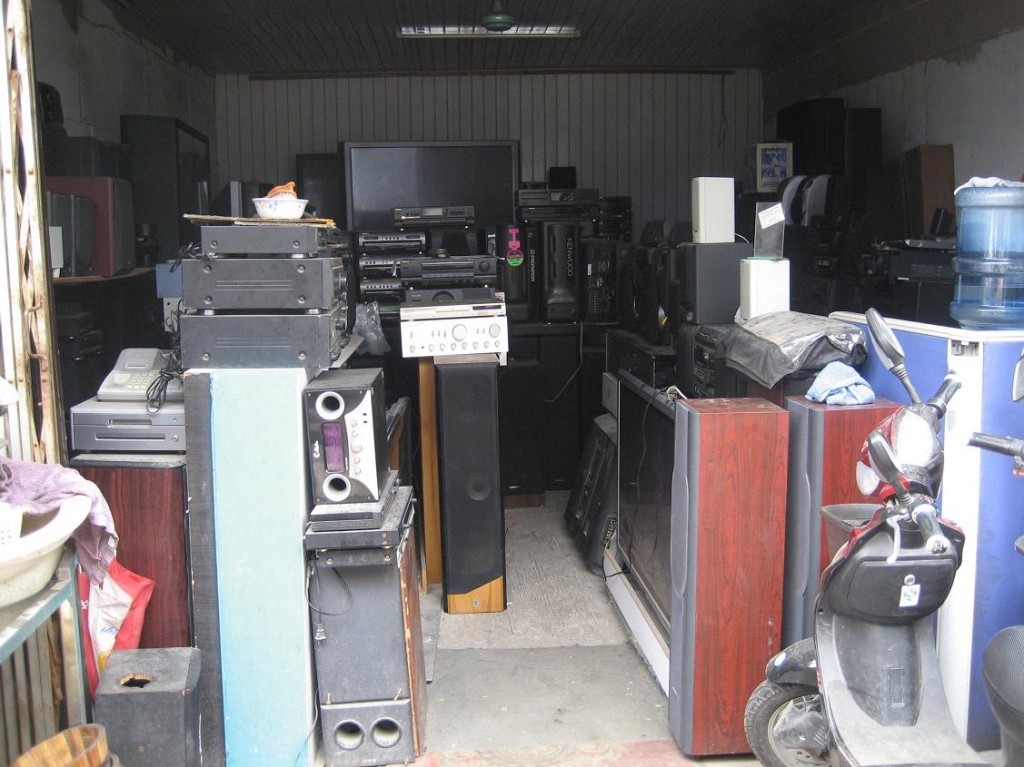
South Gate Market_ A shop corner storing old household electrical appliances
2. some videos from internet highlighting e-waste
HACK – E- Waste
One report investigating e-waste in Australia (then think about China status which is obviously more decades behind)
Pixels
An interesting video metaphorizing the potential destructive power of e-waste.
Posted: April 12th, 2010 | Author: yangwu | Filed under: creative industries | No Comments »
On 2nd April, we, the urban media network team led by Ned Rossiter, carried out a field trip aiming to understand the current situation of Ningbo Creative Industries. Two spots were selected as samples for observation: HeFeng Creative Square and Fortune Creation Harbor. The former one is still on construction, scheduling to open in 2011. The later has on business since June, 2008.
HeFeng Creative Square is located in the east bank of Yao River, opposite to LaoWaiTan. Though only semi-finished architectural complex erects on site, the temporary enclosure wall presents impressive advertisements in order to attract potential companies and financial investment. The stuffs there briefly introduced the industrial property and business scopes of Hefeng Creative Square. With interviewing one of the staffs by Ned Rossiter, we learned the ambition of HeFeng is to establish a flagship industry in providing creative and innovative service to plenty manufactories in Ningbo area, not only compete with local service providers, but also those from Shanghai or others, even foreign countries. When Rossiter asked about what is the decisive advantage for them to compete with other creative clusters. The answer is professional guide and training provided by cluster committee plus the golden location, the center of downtown Ningbo. Since the square occupies a large plot, it will also be integrated with commercial-oriented use like restaurants, hotel, shopping centre, and entertainment.
Later on, we also visit a reserved building whose precursor was a workshop of Hefeng Cotton Mill. It’s now the temporary station for enrolled enterprises. Some are stylish design companies; some are arts and antique stores.
The second spot is Fortune Creation Harbor situated in the North Bank Fortune Centre near to Ningbo Great Theater. At a first sight of the North Bank Fortune Centre, we noticed that though it covers huge territory with several high-end complexes, some offices seem empty and few pedestrians could be observed on site. When we get close to Fortune Creation Harbor, the situation is exactly the same, some companies removed out, some with no clue or little connection towards creative industries.
Referencing to the initial design of Fortune Creation Harbor, it was once a key creative industries project promoted aggressively by JiangBei government. However, two year later, the place even shows more deserted than before. From the field observation, we could assume that Fortune Creation Harbor is somewhat a failure example of creative industries.
Below is the snap show of the field work.
Section 1-HeFeng Creative Square

The planning map showing a large area of territory covered ;

Current Registered Companies Name Wall;

The only one reserved part of old Hefeng Cotton Mill;


Some design companies;


Some art and antique centers;
Section 2-Fortune Creation Harbor

Promotion signboard of Fortune Creation Harbor observed beside Great Theatre;

Mapping North Bank Fortune Centre: a large area of territory and several complexes;


Countless office rooms up there.

The landmark of Fortune Creation Harbor;


Some companies already moved out;

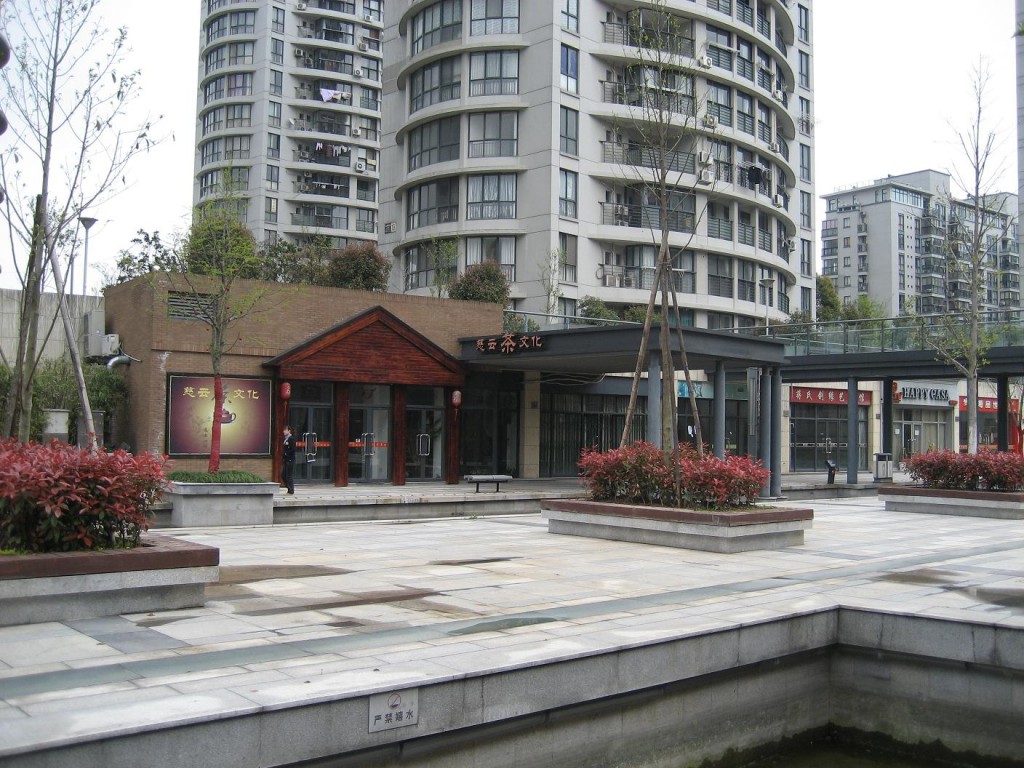
Some show little connection with Creative Industries(might be culture related)
Posted: April 11th, 2010 | Author: Mukda Pratheepwatanawong | Filed under: creative industries | No Comments »
One of the purposes of this article is to raise the awareness that “Planning is important to the success of creative cluster” (8th paragraph).
Even though creative clusters create wealth and employment opportunities for many people, however, it is important to realise that the success of creative cluster depends highly on the efficiency and effectiveness of planning the construction part of the clusters and how to attract investors to invest in creative clusters. As it could take a few years and millions of yuan to construct the clusters, investors should pay high attention to the forecast of economic situation when clusters are completed. This means that if clusters are completed at the time of recession, it would be worrying for investors.
In short, effective and efficient collaboration between investors, governments and other stakeholders is an essential project management skill to manage the construction of creative cluster projects and to deal with any unexpected situations and threats during the construction of after the completion of the cluster.
Posted: April 10th, 2010 | Author: Mukda Pratheepwatanawong | Filed under: creative industries | No Comments »
On Friday 2nd April 2010, Ned Rossiter and all the Urban-Media Networks students visited the Ningbo Industrial Design and Creative Centre (Hefeng), located in downtown Ningbo. The purpose of our visit was to find out more about Hefeng and the current situation in creative industry and creative centre in China, specifically in Ningbo.
From the interview which Ned did with one of the staff at Hefeng, the purposes of Hefeng creative centre are to invest more on Ningbo creative industry, create more jobs for the local people and young graduates. Also, it would like to attract foreign investment, which will give local people the chance to work in diversed working environment and improved working condition.
As every location in China has its own attractive points for business area, Ningbo has the advantage of specialising in manufacturing middle skills electronics. Hefeng creative centre will benefit companies in a way that it offers rent allowance, tax pay-back policy and provide support for creative projects to achieve awards from the government.
The diversed complex has been well-designed and it is expecting a few hundreds companies to invest here.
Further thoughts: From this field trip, I have learned that business strategies should benefit the business in terms of profit making and it should also satisfy stakeholders’ needs. More importantly, it should also create employment opportunities as this will bring benefit to whole country’s economic growth. Even though the creative centre seemed very attractive and well-organised, but I believe that the success of Hefeng creative centre would highly depend on the economic situation of China and how it could adapt to the economics situation and stakeholders needs in a few years time.
Further research: For anyone who is interested in researching more about Hefeng in the future, it would be interesting to keep on track on the construction of Hefeng creative centre and look at the opportunities and threats which Hefeng is facing in the creative industry.
Further information about Hefeng: http://www.nidccn.com/indexen.asp
Posted: April 2nd, 2010 | Author: yuliangzhang | Filed under: creative industries | Tags: creative cluster, creative industry, urban development, urban regeneration | No Comments »
With a purpose to get an indepth understanding of urban development in contemporary China in general, the author will do a case study of an urban regeneration project led by govenment in Ningbo in detail with an interdisciplinary perspective.
The theories supposed to be based on are: global city, creative industry, urban regime and institutional theory, etc.



 →→→
→→→





















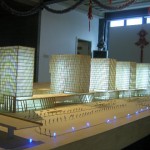



Recent Comments